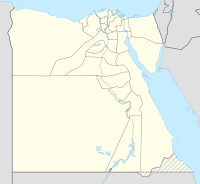This is an old revision of this page, as edited by Antiquistik (talk | contribs) at 01:00, 5 January 2023. The present address (URL) is a permanent link to this revision, which may differ significantly from the current revision.
Revision as of 01:00, 5 January 2023 by Antiquistik (talk | contribs)(diff) ← Previous revision | Latest revision (diff) | Newer revision → (diff) Place in Egypt given to the Hebrews by the pharaoh of Joseph30°52′20″N 31°28′39″E / 30.87222°N 31.47750°E / 30.87222; 31.47750

The land of Goshen (Template:Lang-he, Modern: ʾEreẓ Gōšen, Tiberian: ʾEreṣ Gōšen) is named in the Hebrew Bible as the place in Egypt given to the Hebrews by the pharaoh of Joseph (Book of Genesis, Genesis 45:9–10), and the land from which they later left Egypt at the time of the Exodus. It is believed to have been located in the eastern Nile Delta, lower Egypt; perhaps at or near Avaris, the seat of power of the Hyksos kings.
Meaning of the name
If the Septuagint reading "Gesem" is correct, the word, which in its Hebrew form has no known meaning, may mean "cultivated"—comparing the Arabic root j-š-m, "to labor". Egyptologists have suggested a connection with the Egyptian word qis, meaning "inundated land". Because Goshen was apparently the same region, called by the Greeks the "Arabian nome," which had its capital at Phakousa. The name represented the Egyptian Pa-qas (Brugsch, Geog., I, 298), the name of a town, with the determinative for "pouring forth". Donald Redford, while not disputing the location of Goshen, gives a different origin for the name, deriving it from "Gasmu," the rulers of the Bedouin Qedarites who occupied the eastern Delta from the 7th century BCE, but John Van Seters thinks this unlikely.
Goshen in Egypt
GoshenAccording to the Joseph narrative in the Book of Genesis, the sons of Jacob (Israel) who were living in Hebron, experienced a severe famine that lasted for seven years. Word was that Egypt was the only kingdom able to supply food, and thus the sons of Jacob (Israel) journeyed there to buy goods. In the second year of famine, the Vizier of Egypt, Joseph, invited the sons of Israel to live in Egyptian territory. They settled in the country of Goshen. Goshen is described as the best land in Egypt, suitable for both crops and livestock. It has been suggested that this location may have been somewhat apart from Egypt, because Genesis 46:34 states, "Ye may dwell in the land of Goshen; for every shepherd is an abomination unto the Egyptians." After the death of Joseph and those of his generation, the following generations of Israelites had become populous in number. The Egyptians feared potential integration or takeover, so they enslaved the Israelites.
Four hundred thirty years later, to the day, Moses led the Israelites out of Egypt, from Goshen (Ramesses) to Succoth, the first waypoint of the Exodus. They pitched at 41 locations after initially crossing the Nile Delta to the east, and then also crossing the Red Sea, to the last station being the "plains of Moab".
Identification

The scholars Isaac Rabinowitz, Israel Ephʿal, Jan Retsö, and David F. Graf identify the Land of Goshen with the parts of the Qedarite kingdom of "Arabia" located to the east of the Nile Delta and around Pithom, and which became known to ancient Egyptians as Gsm (𓎤𓊃𓅓𓏏𓊖) and to Jews as the ʾEreṣ Gōšen (אֶרֶץ גֹּשֶׁן), that is the lit. 'Land of Gešem'), after either the Qedarite king Gešem or after his dynasty.
Although the scholar John Van Seters has opposed the identification of ʾEreṣ Gōšen with the Qedarite territories in eastern Egypt based on claims that the Qedarites never ruled the region of the Wādī Ṭumīlāt, the discovery in the the Wādī Ṭumīlāt region of Qedarite remains, such as a shrine to the goddess al-Lāt, makes Van Seters's opposition to this identification untenable.
References
- "www.Bibler.org - Dictionary - Goshen". 2012-10-08.
- ^ Van Seters 2001, pp. 267–269.
- Genesis 45:11
- Genesis 46:34,47:27
- Exodus 12:40
- Numbers 33:5
- numbers 22:1,33:48–50
- ^ Retsö 2013, pp. 300–301.
- Retsö 2013, pp. 250–251.
- ^ Ephʿal 1984, pp. 210–214.
- Rabinowitz 1956.
- Graf 1997, p. 223.
External links
- Ephʿal, Israel (1984). The Ancient Arabs: Nomads on the Borders of the Fertile Crescent, 9th-5th Centuries B.C. Jerusalem: Magnes Press. ISBN 978-0-685-74243-3.
- Graf, David F. (1997). "Palestine: Palestine in the Persian through Roman Periods". In Meyers, Eric M.; Dever, William G.; Meyers, Carol L.; Muhly, James D.; Pardee, Dennis; Sauer, James A.; Finney, Paul Corby; Jorgensen, John S. (eds.). The Oxford Encyclopedia of Archaeology in the Near East. Vol. 4. Oxford, United Kingdom; New York City, United States: Oxford University Press. pp. 222–228. ISBN 978-0-195-06512-1.
- Macalister, R. A. Stewart (1911). "Goshen, a division of Egypt settled by the Israelites between Jacob's immigration and the Exodus" . Encyclopædia Britannica (11th ed.).
- Rabinowitz, Isaac (1956). "Aramaic Inscriptions of the Fifth Century B. C. E. from a North-Arab Shrine in Egypt". Journal of Near Eastern Studies. 15 (1). Chicago, United States: University of Chicago Press: 1–9. Retrieved 1 January 2023.
- Retsö, Jan (2013). The Arabs in Antiquity: Their History from the Assyrians to the Umayyads. London, United Kingdom; New York City, United States: Routledge. ISBN 978-1-136-87289-1.
- Van Seters, John (2001). "The Geography of the Exodus". In Dearman, J. Andrew; Graham, M. Patrick (eds.). The Land that I Will Show You: Essays on the History and Archaeology of the Ancient Near East in Honor of J. Maxwell Miller. Journal for the Study of the Old Testament: Supplement Series. Vol. 343. Sheffield, United Kingdom: Sheffield Academic Press. pp. 255–276. ISBN 978-0-567-35580-5.
